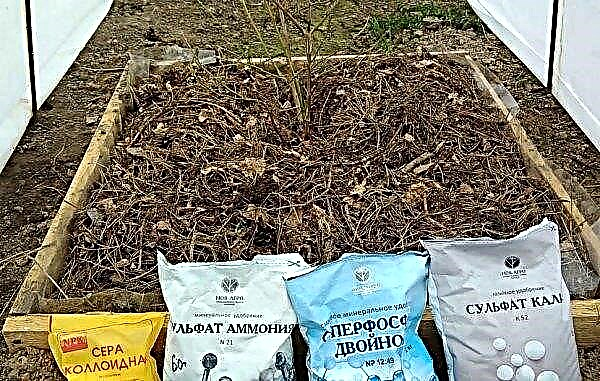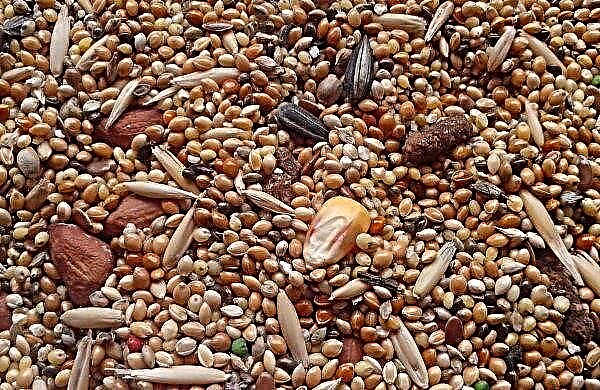In order for the meat bull breeding business to be profitable, not only proper care and intensive feeding is necessary, but also the ability to recognize diseases and cure them in a timely manner. One of the most common diseases in calves is bronchopneumonia.. In this article, we will talk about the causes of its occurrence, symptoms, effects on the body and methods of dealing with this ailment.
What is this disease
Bronchopneumonia (catarrhal pneumonia) is a common disease among small calves. It causes significant economic damage to farms, since it is characterized by high mortality rates. Untimely treatment leads to intoxication of immature organisms and the development of irreversible processes in the respiratory system of animals
Development reasons
Reasons that provokes the development of the disease in cattle:
- stress;
- feed with a small amount of vitamins;
- accommodation of animals in poorly ventilated and uncleaned rooms;
- incorrectly matched pair for mating, which as a result gives offspring with weakened immunity and anatomical failures;
- disruption of the digestive tract.
Important! Observe the optimum temperature at the location of the calf. Hypothermia or overheating can trigger the development of the disease.
The mechanism of the origin and development of the disease
The disease is long and protracted. Initially, it affects the bronchi and develops throughout the bronchial tree. Treatment of a chronic form is difficult. It manifests itself in an acute inflammatory process in the upper respiratory tract, fever and swelling of the nasal mucosa. And only after 3 days there is pneumonia with wheezing. In the acute form, pallor of the mucous membranes and pulmonary edema are observed. The disease most often occurs in calves aged 30 to 45 days.
Symptoms
Manifest depending on the intensity of the disease.
Acute form
Develops up to 10 days. Expressed by lethargy and lack of appetite. If the calf is inactive and refuses to eat, take a closer look at it. Breathing through the mouth, watery eyes, mucus from the nose, which eventually becomes pus, are signs of the disease. A rare cough with a sharp sound is an indicator of the development of an acute form of bronchopneumonia.
It is necessary to call a veterinarian as soon as possible and pass the necessary tests. An ailment determines an elevated white blood cell count. Note that if you ignore the treatment, the calf's health will deteriorate rapidly.
Subacute
At this stage, the animal eats poorly, and therefore does not gain mass. Body temperature remains normal during the day, but in the evening rises by several degrees. The calf has shortness of breath. And diarrhea is a sign of the progress of the disease and its severity. This form of the disease develops from 2 weeks to a month.
Chronic
An animal with a chronic form noticeably lags behind in development. It constantly coughs, mucus flows out of its nose, wheezing is heard in the lungs. Calves with chronic bronchopneumonia do not mate.
Diagnostics
An accurate diagnosis can only be made by a veterinarian based on laboratory tests. Bronchopulmonary and biochemical tests are prescribed. An X-ray examination is also important, which in the presence of a disease shows a blackout in the lungs. Based on the results obtained, the doctor determines the degree of the disease and develops a treatment technique.
Pathological changes
The disease in the process of its development disrupts the functions of all organs and systems. First, the nervous system suffers, which manifests itself in a series of actions that reduce the protective function of the body and provoke blood stasis in the lungs, swelling of the mucous membranes of the bronchioles and bronchi. Since the lungs are weakened, conditions are created in them for the development of inflammatory processes. Reduced gas exchange in them leads to a decrease in gas exchange in the tissues. Lung sites with focal inflammation cannot function as before. Healthy areas have to work in high intensity mode. The animal has shortness of breath and fever. In the kidneys, filtration function is impaired, and protein is traced in the urine. The development of this disease is affected by the condition of the liver and intestines. If the liver barrier is damaged, then toxins pass through it from the intestine, which are absorbed into the bloodstream and cause intoxication of the body.
Lung sites with focal inflammation cannot function as before. Healthy areas have to work in high intensity mode. The animal has shortness of breath and fever. In the kidneys, filtration function is impaired, and protein is traced in the urine. The development of this disease is affected by the condition of the liver and intestines. If the liver barrier is damaged, then toxins pass through it from the intestine, which are absorbed into the bloodstream and cause intoxication of the body.
How to treat
The time of treatment and its effectiveness depends on the conditions in which the "patient" is, and the quality of care for him. Place the calf in a separate box or paddock. Follow all doctor's instructions.
Did you know? The calves are very sociable. On pastures they always keep in groups. After isolation, try to come to the sick as often as possible in order to brighten up their loneliness.
General Therapy
Treatment should be comprehensive, including addressing the causes of the disease. Remember that the symptoms of the disease in their manifestation lead to exhaustion of the animal. To help him maintain his strength to fight the disease and avoid death, give symptomatic treatment. Start with inhalation. It is effective due to the large area of the lungs and their absorption capacity. It also enhances blood circulation. For inhalation, use:
For inhalation, use:
- baking soda;
- turpentine;
- proteolytic enzymes;
- herbal decoctions and infusions;
- oil extracts.
Antibacterial agents
Antibiotics are used to treat the disease. The correct selection of drugs affects the effectiveness of the treatment course. In the acute form of bronchopneumonia, penicillin or streptomycin is prescribed. The second drug is administered intravenously with novocaine. The course of treatment is up to a week. Injection is done three times a day. Antibiotics are injected into the bronchial tree using a special nebulizer.
Did you know? Cows have a good memory; they distinguish people not only visually, but also by voice and smell.
Antiallergic drugs
Treatment is supplemented with antihistamines, which reduce vascular permeability. They are aimed at reducing the likelihood of an allergy to the products of the activity of the pathogen, as well as antibiotics.
Common remedies:
- Suprastin;
- Pipolfen;
- Calcium glucanate;
- Sodium thiosulfate.

Immunostimulants
During the disease, the immune system is weakened, therefore it is necessary for him to help fight the disease. For this, the veterinarian prescribes special immunostimulants. Blood serum is also used, which is taken from healthy calves and poured into the patient. But there are times when treatment is ineffective.
Important! Do not try to treat yourself. Use only drugs prescribed by your veterinarian.
Prevention
The best salvation from the disease is prevention. It consists of:
- proper nutrition;
- intensive and high-quality feeding;
- compliance of premises for animals with such requirements: relative humidity - 70%, without a sharp temperature drop; the air has an ammonia content of not more than 5 mg / m;
- regular walks;
- creating a canopy on the walking area in the heat;
- maintaining cleanliness in the stalls;
- the use of disinfectants;
- the introduction of vitamins in the diet;
- regular examination by a veterinarian;
- quick response to strange behavior and appearance of the calf;
- periodical calf chest massage.
 Bronchopneumonia is a common ailment among calves. Despite its prevalence, it remains little studied. It is important to take preventive measures and start a course of treatment at the first sign. Untimely treatment can cause death and excludes the possibility of obtaining healthy offspring from a sick animal.
Bronchopneumonia is a common ailment among calves. Despite its prevalence, it remains little studied. It is important to take preventive measures and start a course of treatment at the first sign. Untimely treatment can cause death and excludes the possibility of obtaining healthy offspring from a sick animal.












